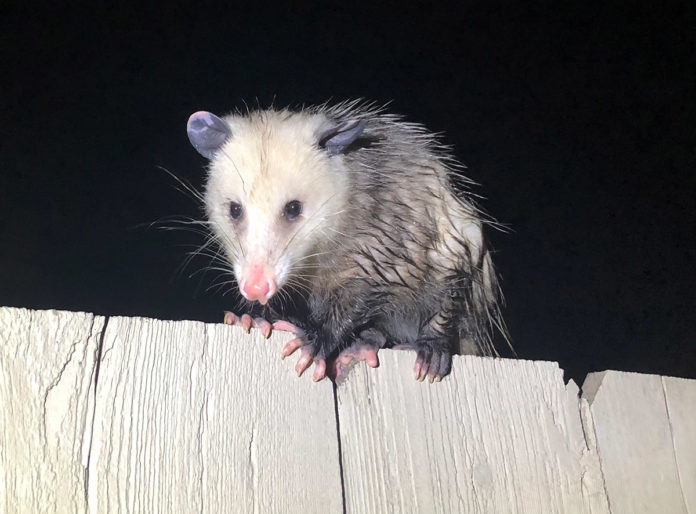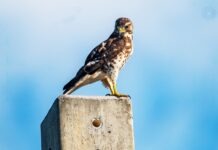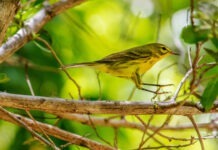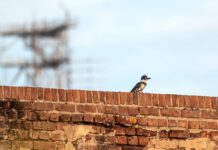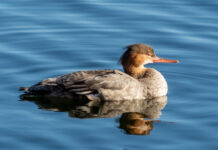There comes a time in every person’s life when he/she/they must take a hard, unsentimental look at their past. They must peer fearlessly into the dark corners, closets and piles of unfolded laundry in their house of memory, and categorize all the events that have come before into the good, the bad, and the things they still have no idea how to think about. (Use of the word vicissitudes is often required.)
It was during one of these long, dark tea times of the soul a couple months ago that I had a shudderingly discomfiting thought: It was quite possible I’d never seen an opossum in the wild. It was possible I’d never seen a living opossum at all.
How, pray tell, could a man live (number redacted) years on the planet without knowing whether he had seen a flesh-and-blood opossum?
The short answer would be callow youth. I wasn’t much interested in the natural world as a kid. I mean, I saw the basic wild mammals of North America – deer, skunks, squirrels, chipmunks, raccoons, etc. Once, while bushwhacking on a mountain bike in the New Jersey Pine Barrens, I was even barked at by a red fox, which was cool.
I became interested in birds in my late 20s and would occasionally go looking for them. But the mammals I’ve seen? Those just happened.
There are, apparently, opossums in the Keys. People occasionally post photos or videos of them wandering the streets of Key West or Key Haven. And I once saw a dead and smooshed one on the road in Marathon.
People like to trash-talk opossums, calling them ugly and saying they look like lazy, overgrown rats that aren’t good at their jobs. It doesn’t help that they have hairless tails, a slow, scrunched walk, mangy-looking fur, and a long pointed snout full of misaligned teeth. People like to project shortcomings onto them – they’re disease-ridden, they have rabies, they’ll steal money from your wallet while you sleep. (They aren’t, they don’t and they will not.)
Occasionally I find myself defending opossums online, despite never having seen one in real life, which requires brushing up on my opossum facts.
First of all, they are ’merica’s marsupials, the only representatives north of Mexico of the order of mammals that includes koalas and kangaroos. Sure, koalas and kangaroos get all the plush toys and cartoon action, but should they? Koalas just get stoned all day on eucalyptus, and kangaroos will grab you by the shoulder and kick you in the crotch if they don’t like the cut of your jib. Opossums, properly called Virginia opossums, at most, will knock over your trashcan and rummage through its contents, which is both productive and non-violent. (By the way, according to Merriam-Webster, “both possum and opossum correctly refer to the Virginia opossum. In common use, possum is the usual term; in technical or scientific contexts opossum is preferred.)
Also, opossums are a vast and living collection of biological weirdness:
They have more teeth in their mouth – 50! – than any other North American mammal. They’re immune to venomous snake bites. Their tail often functions as a fifth limb, allowing them to drag the plants and branches they need for nesting materials to their warrens, and helping them climb trees. (It is not true that possums sleep upside down, gripping tree branches with their tails. They can’t hold on that long.)
Furthermore, their young come into the world blind, nearly translucent and half-formed. Two accounts I read said newborn opossums are smaller than honeybees. One said an entire litter would fit into a tablespoon. Once born, they climb up their mother’s fur and into her pouch, where they attach themselves to one of several (usually 13) nipples, where they remain attached for two months.
There’s also the fact that the whole “playing possum” thing is true. When confronted by a predator they will first open their mouth and hiss. If that doesn’t work, they fall over and lay unmoving with their eyes open. Only it isn’t playing so much as a catatonic state they can’t control that can last for up to six hours. For extra protection, they can also secrete a noxious, green substance from their anal glands that tends to keep predators at bay while they’re unconscious.
Then there is their outright Hieronymus Bosch-ian genitalia.
Females have two-and-a-half vaginas – two for ingress that lead to two separate uteri, and one for egress, which forms to give birth but then closes again when not needed. To accommodate this, males have a bifid penis – basically a split, double-barreled thing that looks not unlike a pale mushroom stalk with devil’s horns. Also, their testicles are in front of their penis. (Sentence I never expected to type: It’s amazing how few high-quality pictures of opossum genitalia one can find online.) All this so confused early colonists that many people believed the male procreated with the female’s nose, and that their babies were born by sneezing.
The question for me was, how does one go about seeing a nocturnal animal that tends to keep to itself? I’d been thinking about this for a couple months, forming vague but elaborate plans, when the dog went running into the backyard the other night, barking her fool head off.
Despite coming from a fancy hunting kennel, she is not a brave dog, and she didn’t get too close to whatever set her off before I grabbed her collar and shoved her back into the house.
I assumed it was a cat or an iguana, but between the scrap lumber pile and the grill I found a long, white face with dark black eyes and smallish, hairless ears staring back at me. A real, live opossum.
I took a step closer and he opened his mouth to show me all 50 of his teeth. He made a loud hissing noise, but it was kind of a pro forma, going-through-the-motions thing, more gestural than emotive.
I yelled to my wife and asked her to bring me my camera, which started a long conversation about where my camera was, because it wasn’t actually where I said it was. When I looked away for a second to figure it out, the opossum made a slow break for the shadows on the other side of the yard, working his way around the fence line. He found the gap he must have come in on, then disappeared into the night.
















